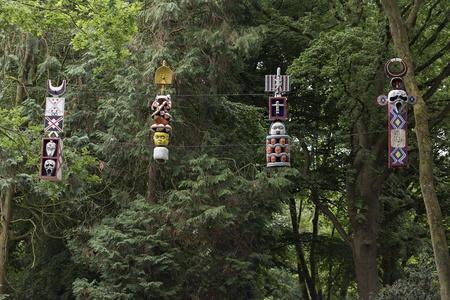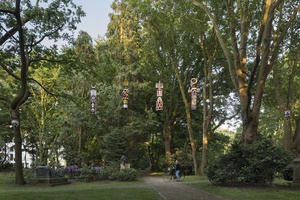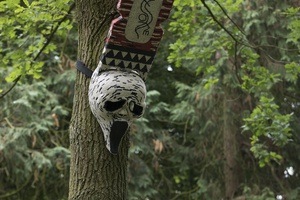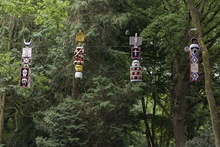Hervé Youmbi
Les masques célèstes [Celestial Masks]
2017
Installation
Wood, glass beads, wood glue, cotton thread, silicone
Dimensions
Large masks
200 × 40 × 45 cm
184 × 46 × 42 cm
193 × 41 × 41 cm
200 × 35 × 31 cm
Small masks
103 × 35 × 27 cm
84 × 37 × 32 cm
82 × 37 × 33 cm
100 × 33 × 27 cm
Location
Überwasser cemetery, Wilhelmstraße / Schlosspark
Temporary installation for the duration of the exhibition
Owner
After Skulptur Projekte 2017 the work was purchased for the collection of LWL Museum für Kunst und Kultur, Münster with the help of a private supporter. It will be shown in temporary exhibitions.
Hervé Youmbi
* 1973 Bangui, Cenral African Republic
lives in Doulala, Cameroon
Hervé Youmbi deals with the African continent’s (post)colonial situation using various media. He contradicts the notion of singular cultural identities by blending iconographic systems from diverse African cultures as well as from Western popular culture.
Youmbi’s installation was located in the disused Überwasser cemetery, near General Ludwig Roth von Schreckenstein’s grave. Suspended among the trees, four massive masks appeared to hover some ten metres from the ground. Another four, smaller masks were mounted directly on the trees. Les Masques célèstes incorporates iconography from popular Western capitalist culture: immediately apparent is the Ghostface mask—from the American horror film Scream (1996) — which was in turn inspired by Edvard Munch’s 1893 painting. This icon of fear is juxtaposed with animistic tokens from many traditional African cultures. According to Youmbi, these animate the spirits of the dead by inviting them to enter and possess the masks during celebratory ceremonies. Youmbi commissioned the masks from workshops in Cameroon. His intervention at a Christian burial site, a location for the commemoration of the dead, raised questions about religion, spirituality, and superstition. Youmbi’s work highlighted the objects and the sites where we make connections between this world and the hereafter and examines what parameters are used to decide whether these customs are valid, effective, or authentic.
A long and problematic history links Western modernity with masks from the African continent. Masks have always been removed from the ritual context in which they were used; they have been seen in purely formal terms as aesthetic sources of inspiration and hung on walls as trophies. The West’s interest in masks and the commercial demand for them led to a boom in the production of masks that still keeps auction-house appraisers in business. It is a history characterized by mystification and fetishism that deals with the authenticity of rituals. It is also well known that many of the objects which are considered genuinely ‘African’ outside of the African continent are really colonial and cultural hybrids. For example, in Les Masques célèstes beads produced in Italy can be found that have been used for centuries in the ritual objects of Cameroon. By using the site-specific context of von Schreckenstein’s grave, Youmbi brought out a particular immediacy: von Schreckenstein is depicted as a tomb effigy — a recumbent figure, asleep with his eyes closed. Above this sculpted figure hovered Youmbi’s heavenly masks. One mask includes the depiction of a bird carrying a lizard on its back. Both animals serve as messengers between this world and the next. Youmbi thus linked a European Christian death cult with (pseudo-)animistic hybrid objects and raised the question, What conditions are needed to make a belief system seem authentic to us?
Nico Anklam
Images
Location
- Still existing / Public Collection
- Removed
- In the museum



